There are the following main differences between low-light-level night vision devices and infrared night vision devices:
Imaging principle
Low-light-level night vision devices: Through image intensifier tubes and other devices, weak natural light in the night sky, such as moonlight and starlight, is collected and enhanced, and weak light signals are converted into electronic signals. After amplification, enhancement and other processing, the electronic signals are converted into visible video images, so that observers can see objects clearly in low-light environments.
Infrared night vision devices: They can be divided into active and passive types. Active infrared night vision devices emit infrared rays through their own infrared searchlights to illuminate the target object, and then receive the infrared radiation reflected by the target to form an image; passive infrared night vision devices do not emit infrared rays, but rely on the infrared radiation emitted by the target itself, and detect the target and form a "thermal image" based on the temperature difference or thermal radiation difference between the target and the background or the target parts.

Applicable environment
Low-light-level night vision devices: require a certain amount of natural light as a basis, and can play a better observation effect in the field environment with weak light such as starlight and moonlight. However, in a completely dark environment, its observation ability will be greatly limited.
Infrared night vision device: Active infrared night vision device can be used in any light conditions, because it can provide infrared light source to illuminate the target; Passive infrared night vision device is not limited by light conditions, and can also work in harsh environments with smoke, mist and other obstructions, and can even monitor through thermal imaging during the day, and can achieve 24-hour all-weather operation.

Imaging characteristics
Low-light night vision device: The imaging effect is closer to natural vision, with higher recognition ability, and the image presented is monochrome, usually green. However, the image contrast of low-light night vision devices is relatively low, the grayscale is limited, the instantaneous dynamic range is poor, and flickering may occur at high gain.
Infrared night vision devices: Active infrared night vision devices have clear images, but the images are easily affected by the intensity and distance of infrared searchlights; passive infrared night vision devices present pseudo-color thermal images, and different colors represent different temperature ranges, requiring users to have certain experience in analyzing and identifying pseudo-color image information.
Observation distance
Low-light night vision devices: The observation distance is relatively close, generally within a few hundred meters, and its observation distance is affected by factors such as ambient light intensity and image intensifier tube performance.
Infrared night vision devices: Active infrared night vision devices have a clear image, but the image is easily affected by the intensity and distance of infrared searchlights; Passive infrared night vision devices present pseudo-color thermal images, and different colors represent different temperature ranges, requiring users to have certain experience in analyzing and identifying pseudo-color image information.

Observation distance
Low-light night vision devices: The observation distance is relatively close, generally within a few hundred meters, and its observation distance is affected by factors such as ambient light intensity and image intensifier tube performance.
Infrared night vision devices: Active infrared night vision devices have a clear image, but the image is easily affected by infrared searchlight intensity and distance. The observation distance of night vision devices is usually between tens of meters and hundreds of meters; the observation distance of passive infrared night vision devices is relatively far, and some high-performance thermal imagers can observe targets thousands of meters or even farther away.

Equipment cost and maintenance
Low-light night vision devices: The technology is relatively mature, the cost is low, and the structure is relatively simple. It is easy to use and maintain, and is not easily detected and interfered by electronic reconnaissance.
Infrared night vision devices: The infrared searchlight of active infrared night vision devices consumes a certain amount of energy and is easy to damage, requiring regular maintenance and replacement; the cost of passive infrared night vision devices is relatively high, especially high-performance thermal imagers are relatively expensive, but the performance is stable and the maintenance cost is relatively low.

